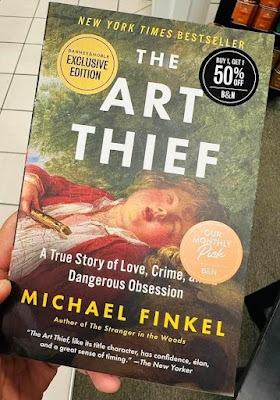“The highest art is always the most religious, and the greatest artist is always a devout person.”
—Abraham Lincoln
By Alex P. Vidal
ALTHOUGH I failed to get an instant discount, the book I purchased, Michael Finkel’s The Art Thief, a New York Times bestseller, earned automatic two stamps for my rewards card at the Barnes and Noble Booksellers on Fifth Avenue in Midtown Manhattan July 17.
It’s a true story of love, crime, and dangerous obsession described by The Wall Street Journal (WSJ) as “Mesmerizing.” The author “tells on enthralling story,” added the WSJ. “From start to finish, this book is hard to put down.”
My interest in The Art Thief was ignited when I saw a Barnes and Noble staff stamping a “buy 1, get 1 50% off” sticker on the book while inquiring from another staff in the counter about the price of another eye-catching book, The Map of Knowledge, written by Violet Moller.
The Art Thief title instantly caught my attention and the recently “solved” Amorsolo painting heist, which was in the Philippine news for a while, entered my mind.
The author tells us about Stephane Breitwieser as “the most prolific art thief of all time.”
-o0o-
Breitwieser pulled off more than 200 heists, often in crowded museums in broad daylight with his girlfriend, Anne-Catherine Kleinklaus, serving as his accomplice.
Breitwieser’s collection was worth an estimated $2 billion, but he never sold a piece, displacing his stolen art in his attic bedroom.
The thief, the author explains, felt like a king until everything came to a shocking end.
In this spellbinding portrait of obsession and flawed genius, the author gives us one of the most remarkable true-crime narratives of our times, a riveting story of art, theft, love, and an insatiable hunger to possess beauty at any cost.
Copyrighted in 2023, a portion of the book was adapted from “The Secrets of the World’s Greatest Art Thief,” originally published on February 28, 2019.
In one very chilling narrative in the book, the author describes the tourists in one museum targeted by the talented thief as “irritating variables.”
“Even at noon there are too many of them, lingering. The more popular room is the museum display paintings by Rubens himself, but these pieces are too large to safely steal or too somberly religious for Breitwieser’s taste,” the author points out.
“The gallery with Adam and Eve features items Rubens collected during his lifetime, including marble busts of Roman philosophers, a terracotta sculpture of Hercules, and a scattering of Dutch and Italian oil paintings. The ivory itself, by the German carver Georg Petel, was likely received by Rubens as a gift.”
-o0o-
The author further brings us in the edge of our seats: “As the tourists circle, Breitwieser positions himself in front of an oil painting and assumes an art-gazing stance. Hands on hips, or arms crossed, or chin cupped. His repertoire includes more than a dozen poses, all meant to connote serene contemplation, even while his heart is revving with excitement and fear.”
The author adds: “Anne-Catherine hovers near the gallery’s doorway, sometimes standing, sometimes sitting on a bench, always with an air of casual indifference, making sure she has a clear view of the hallway beyond. There are no security cameras in the area. There’s only a scattered handful in the whole museum, and he has noted that each has a proper wire; occasionally, in smaller museums, they’re fake.”
In a hair-raising episode, the author goes on: “The moment soon comes when the couple is alone in the room. The transformation is explosive, a flame to the fuel, as Breitwieser shed his studious pose and leaps over the security cordon to the wooden dresser. He digs the Swiss Army knife from his pocket, pries open a screwdriver tool, and sets in to work on the plexiglass box.”
-o0o-
Meanwhile, painted by national artists Fernando Amorsolo in 1936 and titled the “Mango Harvester,” the 88-year-old stolen painting in the Philippines, currently valued between P8 million to P12 million, was reportedly stolen from the Hofileña Museum in Silay City in Negros Occidental on July 3.
According to the news in the Philippines, the National Bureau of Investigation (NBI) was able to arrest two suspects in the theft of the prized painting.
Suspects Ritz Chona Ching and Donecio Somaylo, who were arrested in an NBI entrapment operation along Tomas Morato in Quezon City, reportedly tried to sell the piece for P3.5 million on July 11.
The painting was turned over to the custody of the National Museum after authentication.
(The author, who is now based in New York City, used to be the editor of two daily newspapers in Iloilo.—Ed)



No comments:
Post a Comment